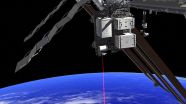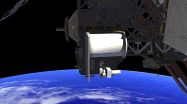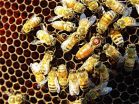HUNTSVILLE, AL, March 05, 2013 (Press-News.org) "OPALS" in space? Well, it's not the gemstones you may be thinking of. This "gem" is an acronym for Optical Payload for Lasercomm Science, or OPALS, an International Space Station experiment that has the potential to change the way data is transmitted from space to Earth.
Currently, spacecraft communicate and send data back to Earth through radio-frequency, much like your car radio. The OPALS investigation will test and demonstrate the use of optical communications. This emerging technology uses lasers to transmit data, and offers the potential promise of much higher return rates.
"The goal of optical communications technology is to increase the science data future missions can bring back for the same amount of resources," said Baris Erkmen, OPALS principal investigator at NASA's Jet Propulsion Laboratory in Pasadena, Calif. "In low Earth orbit, upcoming Earth science missions are generating more data at rates that are much higher than we are able to bring down now, and our investigation aims to improve NASA's ability to get more data down for scientists in the future."
OPALS will demonstrate and test optical communications technologies from a space-based platform by transferring video data via the laser hardware on the space station to a ground receiver at the Jet Propulsion Laboratory's Optical Communications Telescope Laboratory in Wrightwood, Calif.
"Using laser beams, which can be hundreds-to-thousands of times narrower than radio-frequency beams, allows us to achieve higher data rates," said Bogdan Oaida, the OPALS systems engineer at the Jet Propulsion Lab.
As the space station flies over, a laser beacon will transmit from the ground telescope to the payload, where an on-board camera system will track it. While maintaining a lock on the uplink beacon using a closed-loop control system and a two-axis gimbal, the OPALS flight system will downlink a modulated laser beam with a pre-encoded formatted video. "It's like trying to use a laser to point to an area that's the diameter of a human hair from 20-to-30 feet away while moving at half-a-foot per second," added Oaida. "It's all about the pointing."
Each demonstration lasts for approximately two minutes during which the station and ground telescope maintain line-of-sight. The OPALS instrumentation gathers technical data, which researchers then study to determine hardware performance, with the goal of improving the design of next-generation optical communications systems.
The OPALS hardware is targeted to launch to the space station in October 2013, and operate for 90 days. This investigation is part of the Jet Propulsion Laboratory Phaeton Early Career Employee Hands-on Training Program, which engages new scientists and engineers in ongoing, real-time investigations.
For more information on past, ongoing, and future ISS research activities, including research results and publications, please visit:
http://www.nasa.gov/mission_pages/station/research/index.html
If you are interested in subscribing to updates from the ISS Program Science Office, please visit:
https://lists.nasa.gov/mailman/listinfo/iss-program-science-group
For more information about the International Space Station, visit:
http://www.nasa.gov/station
Better Communication is a 'Gem' on Space Station
RELEASE: JR13-014
2013-03-05
ELSE PRESS RELEASES FROM THIS DATE:
Clarity Services, Inc. Gives Lenders Three Credit Scores with Clear Bureau Lite
2013-03-05
Clarity Services, Inc., the leading real-time credit bureau providing fraud detection and credit risk management solutions for Middle America announces its newest product, Clear Bureau Lite.
Clear Bureau Lite is a robust, yet cost effective, report that arms lenders with multiple benchmarks and other variables to assess creditworthiness.
"Clear Bureau Lite provides not one, but three, predictive credit scores to help lenders make better underwriting decisions. It also provides summary trade line information and narrows 1,000 credit attributes down to the 85 that ...
Mysterious electron stash found hidden among Van Allen belts
2013-03-04
U.S. researchers, including a trio from Los Alamos National Laboratory, have witnessed the mysterious appearance of a relatively long-lived zone of high-energy electrons stored between Earth's Van Allen radiation belts.
The surprising findings, discovered by NASA's Van Allen Probes (formerly known as the Radiation Belt Storm Probes), were outlined Thursday in Science Express and during a press conference at NASA headquarters in Washington, D.C. The research was led by Dan Baker of the University of Colorado, Boulder, Laboratory for Atmospheric and Space Physics.
"Nature ...
Gene discovery reveals importance of eating your greens
2013-03-04
Eating your greens may be even more important that previously thought, with the discovery that an immune cell population essential for intestinal health could be controlled by leafy greens in your diet.
The immune cells, named innate lymphoid cells (ILCs), are found in the lining of the digestive system and protect the body from 'bad' bacteria in the intestine. They are also believed to play an important role in controlling food allergies, inflammatory diseases and obesity, and may even prevent the development of bowel cancers.
Dr Gabrielle Belz, Ms Lucie Rankin, Dr ...
Contraband tobacco use hinders smoking cessation
2013-03-04
People who smoke low-cost contraband cigarettes in Canada are less likely to stop smoking in the short term compared with people who smoke more expensive premium or discount cigarettes, according to a study published in CMAJ (Canadian Medical Association Journal).
"We posit that the substantial price gap between premium/discount and contraband cigarettes is the reason for this correlation," writes Graham Mecredy, Ontario Tobacco Research Unit, Toronto, Ontario, with coauthors.
Contraband cigarettes are available in Canada through various channels, including smuggling ...
Contraception in women over 40
2013-03-04
Despite declining fertility, women over age 40 still require effective contraception if they wish to avoid pregnancy. A review article outlines the risks and benefits of various contraceptive options for these women. The article, based on current evidence and published in CMAJ (Canadian Medical Association Journal), is aimed at helping physicians find the best methods for their patients.
The benefits of use outweigh the risks for most contraceptive methods used by women over 40. Even for women with risk factors for complications, methods are available that can be safely ...
Improve prison health care in Canada
2013-03-04
Canada needs to reform its patchwork system of prison health care that does not adequately care for prisoners' complex health care needs, argues an editorial in CMAJ (Canadian Medical Association Journal)
"What is desperately needed is a well-organized and coordinated system of health care, one that follows the offender from the start of his or her incarceration to release and successful return to the community," writes Dr. Ken Flegel, senior associate editor, CMAJ with Dr. Françoise Bouchard, former director general of health services, Correctional Services of Canada.
The ...
Losing weight sooner has best chance to reverse heart damage, mouse study shows
2013-03-04
Johns Hopkins research on obese mice finds that the impact of dieting and losing weight benefits the heart health of the young, but not the older ones
In a study of the impact of weight loss on reversing heart damage from obesity, Johns Hopkins researchers found that poor heart function in young obese mice can be reversed when the animals lose weight from a low-calorie diet. However, older mice, who had been obese for a longer period of time, did not regain better heart function after they were on the same low-calorie diet.
"Our research indicates that the longer mice ...
Researchers id queens, mysterious disease syndrome as key factors in bee colony deaths
2013-03-04
A new long-term study of honey bee health has found that a little-understood disease study authors are calling "idiopathic brood disease syndrome" (IBDS), which kills off bee larvae, is the largest risk factor for predicting the death of a bee colony.
"Historically, we've seen symptoms similar to IBDS associated with viruses spread by large-scale infestations of parasitic mites," says Dr. David Tarpy, an associate professor of entomology at North Carolina State University and co-author of a paper describing the study. "But now we're seeing these symptoms – a high percentage ...
Daily HIV prevention approaches didn't work for African women in the VOICE study
2013-03-04
ATLANTA, March 4, 2013 – Results of a major HIV prevention trial suggest that daily use of a product – whether a vaginal gel or an oral tablet – does not appear to be the right approach for preventing HIV in young, unmarried African women.
Of the three products tested in the VOICE Study – tenofovir gel, oral tenofovir and oral Truvada® – none proved to be effective among the 5,029 women enrolled in the trial; most participants did not use them daily as recommended. Drug was detected in less than a third of blood samples from women who were assigned to use either Truvada ...
Grandmother's cigarette habit could be the cause of grandchild's asthma
2013-03-04
LOS ANGELES – (March. 4, 2013) – Grandmother's cigarette smoking could be responsible for her grandchild's asthma, and the recent discovery of this multi-generational transmission of disease suggests the environmental factors experienced today could determine the health of family members for generations to come, two Los Angeles Biomedical Research Institute (LA BioMed) lead researchers write in the March edition of Review of Obstetrics & Gynecology.
The researchers, John S. Torday, PhD, and Virender K. Rehan, MD, wrote an editorial citing recent studies by Dr. Rehan that ...
LAST 30 PRESS RELEASES:
New expert guidance urges caution before surgery for patients with treatment-resistant constipation
Solar hydrogen can now be produced efficiently without the scarce metal platinum
Sleeping in on weekends may help boost teens’ mental health
Study: Teens use cellphones for an hour a day at school
After more than two years of war, Palestinian children are hungry, denied education and “like the living dead”
The untold story of life with Prader-Willi syndrome - according to the siblings who live it
How the parasite that ‘gave up sex’ found more hosts – and why its victory won’t last
When is it time to jump? The boiling frog problem of AI use in physics education
Twitter data reveals partisan divide in understanding why pollen season's getting worse
AI is quick but risky for updating old software
Revolutionizing biosecurity: new multi-omics framework to transform invasive species management
From ancient herb to modern medicine: new review unveils the multi-targeted healing potential of Borago officinalis
Building a global scientific community: Biological Diversity Journal announces dual recruitment of Editorial Board and Youth Editorial Board members
Microbes that break down antibiotics help protect ecosystems under drug pollution
Smart biochar that remembers pollutants offers a new way to clean water and recycle biomass
Rice genes matter more than domestication in shaping plant microbiomes
Ticking time bomb: Some farmers report as many as 70 tick encounters over a 6-month period
Turning garden and crop waste into plastics
Scientists discover ‘platypus galaxies’ in the early universe
Seeing thyroid cancer in a new light: when AI meets label-free imaging in the operating room
Neutrophil-to-lymphocyte ratio may aid risk stratification in depressive disorder
2026 Seismological Society of America Annual Meeting
AI-powered ECG analysis offers promising path for early detection of chronic obstructive pulmonary disease, says Mount Sinai researchers
GIMM uncovers flaws in lab-grown heart cells and paves the way for improved treatments
Cracking the evolutionary code of sleep
Medications could help the aging brain cope with surgery, memory impairment
Back pain linked to worse sleep years later in men over 65, according to study
CDC urges ‘shared decision-making’ on some childhood vaccines; many unclear about what that means
New research finds that an ‘equal treatment’ approach to economic opportunity advertising can backfire
Researchers create shape-shifting, self-navigating microparticles
[Press-News.org] Better Communication is a 'Gem' on Space StationRELEASE: JR13-014


